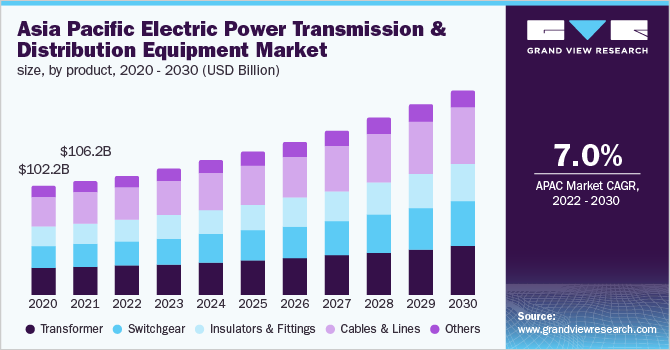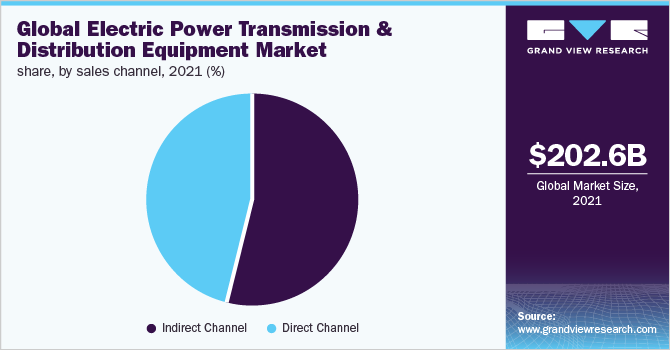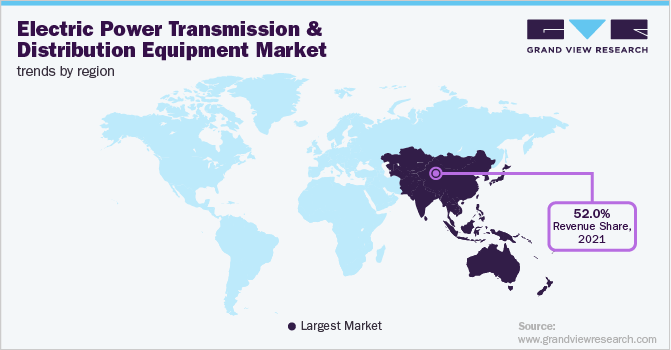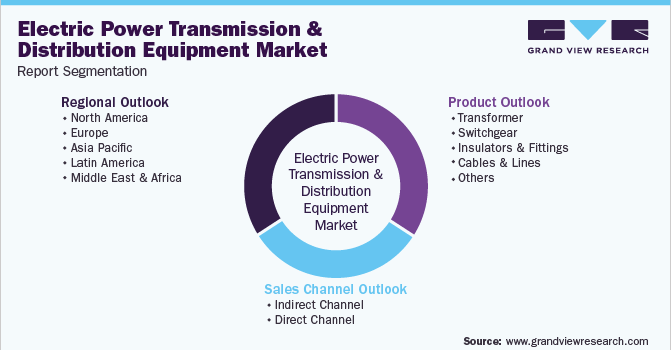- Home
- »
- Automotive & Transportation
- »
-
Electric Power Transmission And Distribution Equipment Market Report, 2030GVR Report cover
![Electric Power Transmission And Distribution Equipment Market Size, Share & Trends Report]()
Electric Power Transmission And Distribution Equipment Market (2022 - 2030) Size, Share & Trends Analysis Report By Product (Transformer, Switchgear, Insulators & Fittings, Cables & Lines), By Application, By Region, And Segment Forecasts
- Report ID: GVR-4-68040-002-2
- Number of Report Pages: 120
- Format: PDF
- Historical Range: 2018 - 2020
- Forecast Period: 2022 - 2030
- Industry: Technology
- Report Summary
- Table of Contents
- Interactive Charts
- Methodology
- Download FREE Sample
-
Download Sample Report
Electric Power Transmission And Distribution Equipment Market Summary
The global electric power transmission and distribution equipment market size was estimated at USD 202.6 billion in 2021 and is projected to reach USD 326.5 billion by 2030, growing at a CAGR of 5.7% from 2022 to 2030. The advancement in electric power transmission and distribution equipment to fulfill the rising demand for electricity from the residential, commercial, and industrial sectors is propelling the global market growth.
Key Market Trends & Insights
- Asia Pacific dominated the global electric power transmission and distribution equipment market with the largest revenue share of more than 52.0% in 2021.
- By product, the cables and lines segment led the market with the largest revenue share of more than 26.2% in 2021.
- By sales channel, the indirect channel segment led the market with the largest revenue share of more than 54.4% in 2021.
Market Size & Forecast
- 2021 Market Size: USD 202.6 Billion
- 2030 Projected Market Size: USD 326.5 Billion
- CAGR (2022-2030): 5.7%
- Asia Pacific: Largest market in 2021
In addition, the introduction of various on-shore and off-shore projects by the government to generate electricity to cater to rising energy demand will result in the deployment of efficient switchgear, transformers, and meters for smooth power transmission and distribution.

The government of countries such as Germany, the UK, the Netherlands, China, and more is focused on developing offshore wind power generation systems, which are expected to generate demand for advanced T&D equipment. Their inclination toward adopting clean energy to cater to the rising electricity demand from the industrial and residential sectors is to impact the global market growth positively. For instance, in May 2022, the launch of Interconnection Innovation e-Xchange (i2X) by the Biden Administration, through the U.S. Department of Energy (DOE), brought together the grid utilities, operators, tribal and state government, energy justice organizations, and other stakeholders to solve America’s power grid challenges and drive more clean energy to the power industry which is expected to drive the growth of the market.
The growing adoption of electric vehicles (EV) is creating demand for electric power transmission and distribution equipment to establish efficient electric vehicle infrastructure. Countries such as China, Germany, France, the U.S., South Korea, and Japan are the leading adopters of EVs. Governments of emerging economies such as Thailand and Indonesia are aiming for the deployment of EVs, and this further is creating a positive impact on the global energy systems, which are responsible for market growth.
Renewable energy sources such as wind, biomass, solar, geothermal energy, and hydroelectric power are the major sources of green energy. These renewable energy sources provide environmental benefits, minimize the dependency on fossil fuels, and reduce electricity costs. According to the study published by the U.S. Energy Information Administration (EIS), in May 2022, solar and wind energy are expected to be the largest renewable energy source for US electricity generation. The US EIS forecasts an increase of 10 Billion-Mega Watthours (MWh) in solar energy generation between June and August 2022 compared to the previous year's period. Further, wind energy generation is also expected to increase by 8 billion MWh during the same period. The study predicts an increase of 31 percent in solar energy since June 2021, estimated to generate 65 GW of utility-scale solar energy in the US electric power sector. This growing demand for green energy in the global energy sector is driving the need for efficient electric power transmission and distribution equipment supporting the market growth.
The COVID-19 pandemic caused the power sector to slow as more and more countries implemented nationwide lockdowns to prevent further disease outbreaks. Due to economic contractions, there has been a slowdown in demand for power from various countries and end-use industries. For instance, in 2020, due to the lockdown, India's electricity demand dropped by 20-25%, affecting distribution utilities' revenues. The country's distribution companies face a revenue deficit of USD 1.7 billion per month
The lack of skilled technical labor to cope with digitalization to drive decarburization in the power, petrochemical, and renewable sectors is expected to hinder the market growth. A shortage of labor with the relevant knowledge and expertise, along with the poor recruitment process in the organization, is highly impacting the energy sector and the demand for market growth over the forecast period. Henceforth, the shortage of skilled labor owing to multiple reasons across the energy sector is anticipated to hamper the growth of the electric power transmission and distribution equipment market globally.
Product Insights
The cable and lines segment dominated the market and accounted for more than 26.2% of the global revenue share in 2021. The market growth is expected to be driven by the smart upgrading of distribution systems, power transmission, and the development of smart grids. Due to smart grid technology, increasing demand for interconnections has resulted in increased investments in submarines and underground cables.
The transformer segment is expected to expand at a CAGR of 5.2% from 2022 to 2030. Demand for power transformers has risen as infrastructure spending and favorable norms associated with growing and refurbishing existing grid networks have increased. In addition, rapid urbanization and industrial expansion in developing economies will increase power transformer demand. Power transmission and distribution projects have steadily increased transformer capacity in many countries. For example, in 2020, there were 1,14,807 Mega Volt Amp (MVA) of transformer capacity deployed in Mexico's distribution network.
Sales Channel Insights
The indirect channel dominated the market and accounted for more than 54.4% of the global revenue share in 2021. The indirect channel segment is divided into four subsegments: commercial distribution, catalog distribution, retail box stores, and e-commerce. The commercial distribution subsegment holds the largest market share owing to the rise in the adoption of value-added services, distributor-managed inventory, and credit financing. The increase in e-commerce sales grew by more than 200% in 2021, which is expected to drive market growth.

The direct channel is expected to expand at the fastest CAGR of 6.2% from 2022 to 2030.Increasing consumer demand for checking and validating a product before purchasing mainly drives the growth of the global market. For instance, in 2020, according to the World Federation of Direct Selling Associations (WFDSA), over 125.4 billion direct sellers are expected to be involved in the direct selling industry.
Regional Insights
Asia Pacific region dominated the market and accounted for more than 52.0% of the global revenue share in 2021, which can be attributed to increasing construction activities, urbanization, electricity demand, and industrialization in the region. The growth of the market is expected to be fueled by investments from countries such as India, China, Vietnam, and the Philippines in grid expansion projects.

Europe emerged as the second-largest regional market in 2021 and is likely to expand further at a steady growth rate of 5.1% during the forecast period. Rising electricity consumption and increasing demand for advanced power transmission and distribution equipment in automotive and electronics are expected to drive the region's growth.
Key Companies & Market Share Insights
The market is consolidated and most of the players are focused on mergers and acquisitions, product launches, and partnerships. Some of the prominent players in the global electric power transmission and distribution equipment market include:
-
ABB
-
Siemens
-
GE
-
Schneider Electric
-
Eaton
Electric Power Transmission And Distribution Equipment Market Report Scope
Report Attribute
Details
Market size value in 2022
USD 209.65 billion
Revenue forecast in 2030
USD 326.5 billion
Growth rate
CAGR of 5.7% from 2022 to 2030
Base year for estimation
2021
Historical data
2018 - 2020
Forecast period
2022 - 2030
Quantitative units
Revenue in USD billion and CAGR from 2022 to 2030
Report coverage
Revenue forecast, company ranking, competitive landscape, growth factors, and trends
Segments covered
Product, sales channel, region
Regional scope
North America, Europe, Asia Pacific, Latin America, Middle East & Africa
Country scope
U.S.; Canada; U.K.; Germany; France; Italy; Spain; Rest of Europe; China; India; Japan; South Korea; ASEAN; Rest of Asia Pacific; Brazil; Mexico; Rest of Latin America
Key companies profiled
ABB; Siemens; Schneider Electric; GE; Eaton
Customization scope
Free report customization (equivalent to up to 8 analysts’ working days) with purchase. Addition or alteration to country, regional & segment scope.
Pricing and purchase options
Avail customized purchase options to meet your exact research needs. Explore purchase options
Global Electric Power Transmission And Distribution Equipment Market Segmentation
This report forecasts revenue growth at the global, regional, and country levels and analyzes the latest industry trends from 2018 to 2030 in each sub-segment. For this study, Grand View Research has segmented the global electric power transmission & distribution equipment market report based on product, sales channel, and region:

-
Products Outlook (Revenue, USD Billion, 2018 - 2030)
-
Transformer
-
Power Transformer
-
Distribution Transformer
-
-
Switchgear
-
Circuit Breaker
-
Fuse
-
Distribution Control Panel
-
Others
-
-
Insulators & Fittings
-
Cables & Lines
-
Others
-
-
Sales Channel Outlook (Revenue, USD Billion, 2018 - 2030)
-
Indirect Channel
-
Commercial Distribution
-
Catalog Distribution
-
Retail Box Stores
-
Ecommerce
-
-
Direct Channel
-
-
Regional Outlook (Revenue, USD Billion, 2018 - 2030)
-
North America
-
U.S.
-
Canada
-
-
Europe
-
U.K.
-
Germany
-
France
-
Italy
-
Spain
-
Rest of Europe
-
-
Asia Pacific
-
China
-
India
-
Japan
-
South Korea
-
ASEAN
-
Rest of Asia Pacific
-
-
Latin America
-
Brazil
-
Mexico
-
Rest of Latin America
-
-
Middle East & Africa
-
Frequently Asked Questions About This Report
b. The global electric power transmission and distribution equipment market size was estimated at USD 202.6 billion in 2021 and is expected to reach USD 209.65 billion in 2022.
b. The global electric power transmission and distribution equipment market is expected to grow at a compound annual growth rate of 5.7% from 2022 to 2030 to reach USD 326.5 billion by 2030.
Which segment accounted for the largest electric transmission & distribution equipment market share?b. Asia pacific dominated the electric transmission & distribution equipment market with a share of 52.40 % in 2021. This is attributable to rapid advancement in electric power transmission and distribution equipment to fulfill the rising demand for electricity from the residential, commercial, and industrial sectors.
b. Some key players operating in the electric transmission & distribution equipment market include ABB, Siemens, GE, Schneider Electric SE, and Eaton
b. Key factors that are driving the electric power transmission and distribution equipment market growth include the introduction of various on-shore and off-shore projects by the government to generate electricity to cater to rising energy demand will result in the deployment of efficient switchgear, transformers, and meters for smooth power transmission and distribution.
Share this report with your colleague or friend.
Need a Tailored Report?
Customize this report to your needs — add regions, segments, or data points, with 20% free customization.

ISO 9001:2015 & 27001:2022 Certified
We are GDPR and CCPA compliant! Your transaction & personal information is safe and secure. For more details, please read our privacy policy.
Trusted market insights - try a free sample
See how our reports are structured and why industry leaders rely on Grand View Research. Get a free sample or ask us to tailor this report to your needs.










